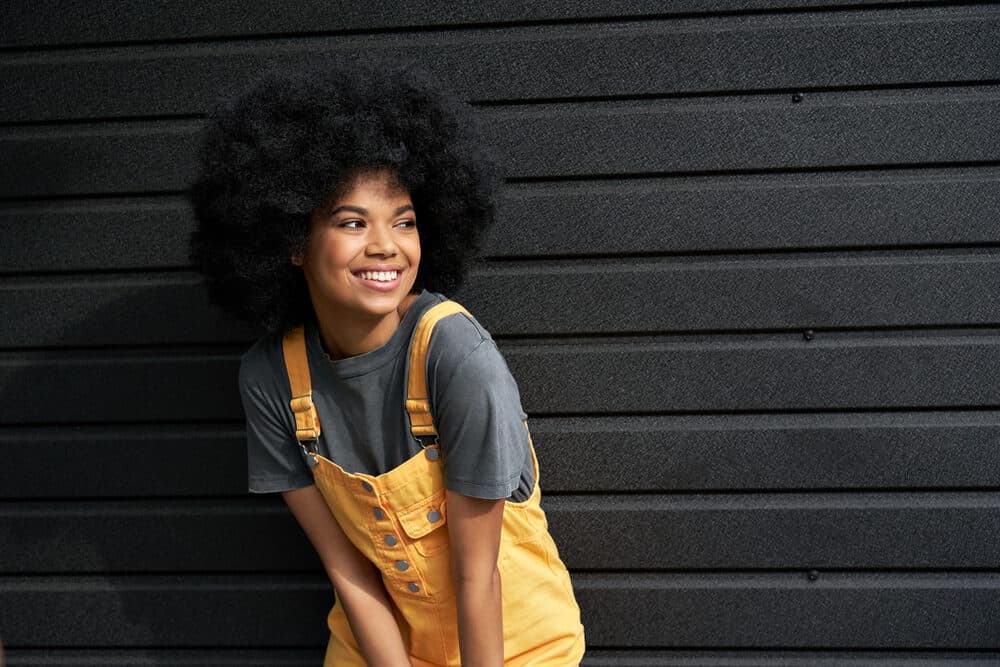
Your ideal hair moisturizing regimen has a lot to do with your hair porosity. Unfortunately, many naturals have no idea what hair porosity is, much less what it means for hair hydration.
Chances are you’ve stumbled upon this article because you've been struggling to keep your low-porosity hair moisturized. Well, we've got good news, you are in the right place. This article will give you an in-depth overview of how to moisturize low-porosity hair.
Table of Contents
- 1 What Is Low Porosity Hair?
- 2 How to Moisturize Low Porosity Hair
- 3 How Often to Moisturize Low Porosity Hair
- 4 Top Moisturizers for Low Porosity Hair
- 4.1 Jojoba Oil
- 4.2 Grapeseed Oil
- 4.3 Avocado Oil
- 4.4 Glycerin
- 4.5 Aloe Vera
- 4.6 How Do You Moisturize Low-Porosity Hair?
- 4.7 Is Shea Moisture Manuka Honey for Low-Porosity Hair?
- 4.8 Is Camille Rose Good for Low-Porosity Hair?
- 4.9 Is TGIN Good for Low-Porosity Hair?
- 4.10 Is Curls Blueberry Bliss Good for Low-Porosity Hair?
- 4.11 Is LCO or LOC Method Better for Low-Porosity Hair?
- 4.12 Is Leave-in Conditioner Good for Low-Porosity Hair?
- 4.13 Is Low Porosity Hair Bad?
- 4.14 What Ingredients Are Bad for Low-Porosity Hair?
- 4.15 Related Articles

What Is Low Porosity Hair?
Some people think they have low porosity hair when, in fact, they don’t. So, we’d like to start this article by defining what low porosity hair means.
Low-porosity hair is made up of strands with a tightly packed cuticle layer. The layer is bound so tightly that there are barely any openings for water or moisture-containing products to penetrate the strands.
In other words, your strands are water and moisture-resistant. This natural resistance can lead to brittle, parched, breakage-prone strands.
In addition, low-porosity hair takes a long time to release moisture once it’s been absorbed. One exception is when you shampoo your hair.
Here’s how to find out whether you have low-porosity hair. Think back to the last time you washed your hair:
- Did it take more than a few seconds for your whole head to become saturated with water? If the answer is yes, then you may have low porosity hair.
- Did it take hours and hours (up to 24 hours) for your hair to dry after rinsing? If you answered yes to this question, you likely have low porosity hair.
If you want to be "doubly sure" that you have low porosity hair, you can try the float test. Note: While the float test is a fun "directionally correct" way to test for hair porosity, it's not a scientifically reliable method. It's pseudoscience, but it's fun.
In general, hair will float in water. Most people that complete the float test will observe that your hair floats for a long time and may eventually sink if it does at all.
This long float is because hair your hair is naturally coated with oil. Any additional hair product you use in your hair care regimen will have an added impact.
Oil will always float on water, so your hair floating does not indicate low porosity. It simply indicates that your hair is light and has an oil coating that repels water.
Suppose you chose to do the test with freshly washed hair, but you don't condition your hair after washing it. In that case, that is an artificial test if you would typically apply conditioner after a shampoo.
Regardless, hair will still float for most people because there is usually still some residual oil remaining on the hair.
The temperature of the water has also been a subject of debate. Some people maintain that it makes no difference, but this is incorrect since warmer temperatures can remove some of the hair's oil. However, the most common observation that people will make when viewing a single strand of hair is that it will float.
How to Moisturize Low Porosity Hair
If you have reached this point and realized that you have low-porosity hair, there are various methods you can use to unlock your hair's ultimate hydration potential.
In this section, we will share helpful tips and tricks for moisturizing low-porosity hair to help you keep your hair hydrated.
1. Develop a Pre-poo Routine
"Pre-poo" is short for pre-shampoo. A pre-poo routine is used to prep your hair before shampooing. Since low-porosity hair tends to be stripped of moisture during the cleansing process, you'll want to protect and moisturize your strands as much as possible beforehand.
A pre-poo treatment can include products you commonly use on your hair. If you have natural oils like grapeseed oil or jojoba oil on hand, use them.
All of these oils are lightweight enough to penetrate your low-porosity hair strands and provide deep hydration. You can also use a conditioner combined with either one of these oils.
Follow the steps below to complete a simple pre-poo:
- While your hair is completely dry, divide it into four to eight sections. This will make the pre-poo treatment easier to distribute.
- Cover each section of your hair with your pre-poo treatment. Be sure to cover each section from root to tip. Be generous with the product(s) and ensure that every strand is covered.
- Gently detangle each section of hair with a wide-tooth comb.
- Allow the pre-poo treatment to sit for at least 30 minutes. The longer you allow it to sit on your hair, the better. You can even leave the treatment on overnight. Just be sure to wear a silk or satin scarf or a shower cap to keep your sheets clean.
- Lastly, shampoo your hair as usual.

2. Add Heat to Your Conditioning Routine
Heat can take your conditioning routines to the next level. It has sort of an “unlocking” effect on your normally closed cuticle layers. Adding heat to your conditioning sessions will cause those layers to open up, allowing water and moisture in.
Heat also helps your conditioner to work optimally. Oil-based conditioners are composed of fat molecules that your hair needs to absorb moisture.
In the presence of heat, these fat molecules break down easier, enabling your hair strands to absorb those much-needed oils.
You'll hear different names from these treatments within the natural hair community. Hot oil treatments and deep conditioning treatments are common descriptions of similar processes with slight variations.
To reap the benefits of heated conditioning treatments, you have a few options:
- After applying your conditioner, steam your hair for a few minutes.
- Sit under a hooded dryer for 5 to 10 minutes after applying your conditioner. You can use low to medium heat on the hooded dryer - we advise you to avoid high heat so as not to cause heat damage.
- Wear a heated cap for the duration of your deep conditioning treatment or moisturizing session.

3. Try the “Greenhouse” Method
The greenhouse method is a quick moisture-boosting procedure that you complete after using your favorite moisturizer. Naturals everywhere use this method to prevent moisture loss and dryness after cleansing their hair.
Here’s how to do the greenhouse method:
- Begin by applying an oil or a cream-based moisturizer to your clean damp hair.
- Cover your head with a plastic cap. If you're in a pinch, you can use that plastic grocery bag you’ve got in the pantry.
- Leave your head covered overnight. Don't be surprised if you see water droplets on your cap the next day. This is condensation from the heat of your head and the moisture in the cap.
- Rinse your hair thoroughly in the morning.
How Often to Moisturize Low Porosity Hair

There is no exact frequency at which you should moisturize your low-porosity hair. This is because moisture retention and loss vary from person to person.
But the good news is that, generally, your hair will tell you when it is thirsty. When your hair feels dry to the touch, don't be afraid to moisturize it. Most people with low porosity hair moisturize two to five times a week.
Top Moisturizers for Low Porosity Hair

Not all moisturizers are created equal when it comes to hydrating your low-porosity hair. There are certain ingredients you'll want to look for in your go-to moisturizers, deep conditioners, and leave-ins to promote moisture. They include:
Jojoba Oil
Jojoba oil is a natural oil that is derived from the jojoba plant. It is similar in composition to the natural oils that our scalp produces, called sebum. This makes the oil easy to distribute and absorb into the hair strands.
Grapeseed Oil
Grapeseed oil is a gem for low-porosity hair because it’s lightweight, which makes for easy hair penetration. Heavier oils like olive oil tend to weigh the hair down, making moisture retention next to impossible for low-porosity hair. Grapeseed oil is widely loved for its thermal properties. It can protect the hair from damage caused by flat irons and blow dryers.
Avocado Oil
Avocado oil is slightly heavier than the other oils discussed above. However, it is a go-to for people with low-porosity hair. Its ability to saturate hair strands with moisture is well-known.
Glycerin
Glycerin is a humectant that draws moisture into your hair from the environment. You’ll find glycerin in tons of natural hair products aimed at hydrating hair.
Aloe Vera
Aloe vera is extremely moisturizing to the hair and has humectant properties. Just like glycerin, it attracts moisture from the environment into your hair. Use these ingredients alone or with other moisturizers for maximum moisture retention.
How Do You Moisturize Low-Porosity Hair?
There are several ways to moisturize low-porosity hair. Use warm water to wash, deep condition regularly, apply a lightweight leave-in conditioner, avoid heavy products, use a hair steamer, clarify once a month, and protect your hair from damage. These techniques will help to open up the cuticle and allow moisture to penetrate the hair shaft.
Is Shea Moisture Manuka Honey for Low-Porosity Hair?
Shea Moisture Manuka Honey & Mafura Oil Intensive Hydration Hair Care line is designed to moisturize and nourish low-porosity hair. This line is formulated with ingredients such as Manuka Honey, Mafura Oil, and Baobab Oil, which are known to provide intense hydration and penetrate the tightly closed cuticles of low-porosity hair.
Is Camille Rose Good for Low-Porosity Hair?
Many Camille Rose products are great for low-porosity hair. Any products formulated with natural and nourishing ingredients such as coconut oil, aloe vera, and honey helps moisturize and soften low-porosity hair. Some of their popular products for this hair type include the Curlaide Moisture Butter, Algae Renew Deep Conditioner, and Coconut Water Leave-In Treatment.
Is TGIN Good for Low-Porosity Hair?
TGIN (Thank God It's Natural) is a natural hair care brand that offers some products designed for low-porosity hair. Many of their products contain natural and nourishing ingredients like shea butter, coconut oil, and argan oil that are great for softening low-porosity hair. TGIN's products are free from harsh sulfates, parabens, and phthalates, making them a good choice.
Is Curls Blueberry Bliss Good for Low-Porosity Hair?
Curls Blueberry Bliss is a hair care line that offers a variety of products formulated with natural ingredients, including blueberry extract, which is known for its antioxidant properties. While the brand does not specifically target low-porosity hair, many of its products can still be beneficial. Some products contain natural oils and humectants that moisturize and nourish low-porosity hair.
Is LCO or LOC Method Better for Low-Porosity Hair?
Both the LCO (Liquid, Cream, Oil) and LOC (Liquid, Oil, Cream) methods are effective, but the LCO method may be better suited for this hair type. Low-porosity hair is resistant to moisture, so using a liquid or water-based product as the first step in the LCO method opens up the hair cuticles and allows for better absorption of moisture.
Is Leave-in Conditioner Good for Low-Porosity Hair?
Leave-in conditioner can be very good for low-porosity hair. It's resistant to moisture, so using a leave-in conditioner after washing provides additional moisture and nourishment to the hair. Look for leave-in conditioners that contain natural and lightweight ingredients, such as aloe vera, glycerin, and coconut oil, which can help to moisturize and soften the hair without weighing it down.
Is Low Porosity Hair Bad?
Low porosity hair is not bad; it simply requires specific attention to maintain its health and manageability. A tightly closed cuticle layer makes it difficult for products to penetrate the hair shaft. This leads to breakage if it's not properly moisturized. However, with the right hair care routine, low-porosity hair can be healthy, shiny, and beautiful.
What Ingredients Are Bad for Low-Porosity Hair?
Ingredients to avoid or use in moderation on low-porosity hair include heavy oils (like mineral oil, lanolin oil, and castor oil), excess protein, silicones, alcohol, and sulfates. These ingredients cause build-up, prevent moisture absorption and make low-porosity hair feel dry and brittle. Pay attention to how your hair responds to different ingredients and adjust your hair care accordingly.
- How To Do a Porosity Test on Hair
- Best Moisturizers for Low Porosity Hair
- How Often Should You Moisturize Your Hair
- LOC Method for 4c Hair
As you can see, low-porosity hair requires very targeted care to accommodate its distinct structure. We hope that this article has provided you with the tools you need to overcome low porosity hair issues or help someone else who’s dealing with this common issue. By implementing the tips and techniques outlined in this article, you will be well on your way to moist, luxurious curls.




